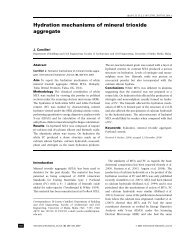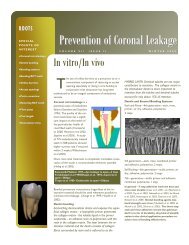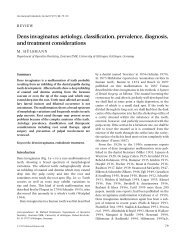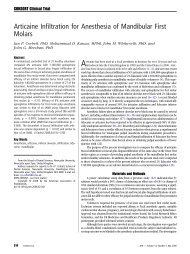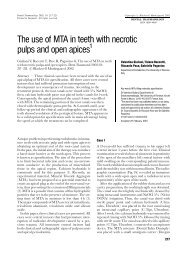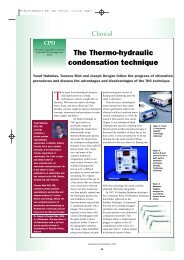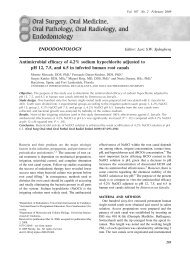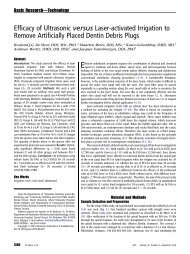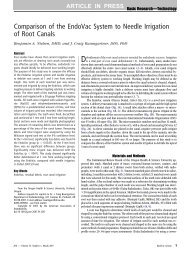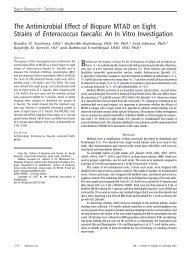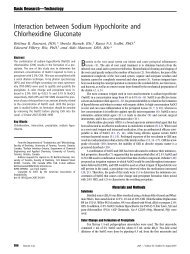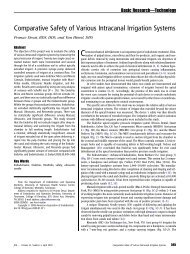Irrigation in Endodontics - The Endoexperience
Irrigation in Endodontics - The Endoexperience
Irrigation in Endodontics - The Endoexperience
You also want an ePaper? Increase the reach of your titles
YUMPU automatically turns print PDFs into web optimized ePapers that Google loves.
<strong>Irrigation</strong> <strong>in</strong> <strong>Endodontics</strong> 305<br />
Organization size 0.42 and 30 G to size 0.31, smaller needle sizes are preferred.<br />
Several studies have shown that the irrigant has only a limited effect beyond the tip<br />
of the needle because of the dead-water zone or sometimes air bubbles <strong>in</strong> the apical<br />
root canal, which prevent apical penetration of the solution. However, although the<br />
smaller needles allow delivery of the irrigant close to the apex, this is not without safety<br />
concerns. Several modifications of the needle-tip design have been <strong>in</strong>troduced <strong>in</strong><br />
recent years to facilitate effectiveness and m<strong>in</strong>imize safety risks (Figs. 17 and 18).<br />
<strong>The</strong>re are few comparative data about the effect of needle design on irrigation effectiveness;<br />
it is hoped that ongo<strong>in</strong>g CFD and cl<strong>in</strong>ical studies will change this situation.<br />
Gutta-percha Po<strong>in</strong>ts<br />
<strong>The</strong> recognition of the difficulty of apical canal irrigation has led to various <strong>in</strong>novative<br />
techniques to facilitate the penetration of solutions <strong>in</strong> the canal. One of these <strong>in</strong>cludes<br />
the use of apically fitt<strong>in</strong>g gutta-percha cones <strong>in</strong> an up-and-down motion at the work<strong>in</strong>g<br />
length. Although this facilitates the exchange of the apical solution, the overall volume<br />
of fresh solution <strong>in</strong> the apical canal is likely to rema<strong>in</strong> small. However, the benefits of<br />
gutta-percha po<strong>in</strong>t assisted irrigation have been shown <strong>in</strong> 2 recent studies. 64,65<br />
EndoActivator<br />
EndoActivator (Advanced <strong>Endodontics</strong>, Santa Barbara, CA, USA) is a new type of<br />
irrigation facilitator. It is based on sonic vibration (up to 10,000 cpm) of a plastic tip<br />
<strong>in</strong> the root canal. <strong>The</strong> system has 3 different sizes of tips that are easily attached<br />
(snap-on) to the handpiece that creates the sonic vibrations (Fig. 19). EndoActivator<br />
does not deliver new irrigant to the canal but it facilitates the penetration and renewal<br />
of the irrigant <strong>in</strong> the canal. Two recent studies have <strong>in</strong>dicated that the use of EndoActivator<br />
facilitates irrigant penetration and mechanical cleans<strong>in</strong>g compared with needle<br />
irrigation, with no <strong>in</strong>crease <strong>in</strong> the risk of irrigant extrusion through the apex. 66,67<br />
Fig. 17. Four different needle designs, produced by computerized mesh models based on<br />
true and virtual needles.



